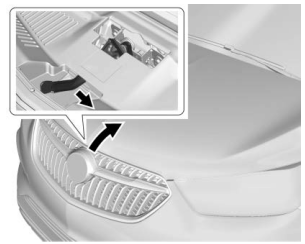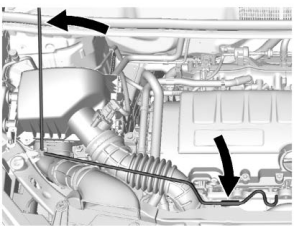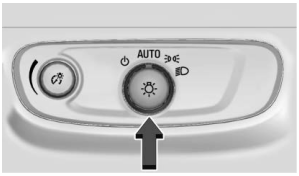Buick Encore: Vehicle Checks / Hood
Warning
Turn the vehicle off before opening the hood. If the engine is running with the hood open, you or others could be injured.
Warning
Components under the hood can get hot from running the engine. To help avoid the risk of burning unprotected skin, never touch these components until they have cooled, and always use a glove or towel to avoid direct skin contact.
Clear any snow from the hood before opening.
To open the hood:
- Pull the hood release lever with the
 symbol. It is on the lower left
side
of the instrument panel.
symbol. It is on the lower left
side
of the instrument panel.
- Go to the front of the vehicle and locate
the secondary release lever under the
front center of the hood. Push the
secondary hood release lever to the right
to release.

- Lift the hood and release the hood prop rod from its retainer, in the front of the engine compartment. Securely insert the rod end into the slot marked with an arrow, on the underside of the hood.
To close the hood:
- Before closing the hood, be sure all filler caps are on properly, and all tools are removed.
- Lift the hood and remove the hood prop rod from the underside of the hood. Return the prop rod to its retainer. The prop rod must click into place when returning it to the retainer to prevent hood damage.
- Lower the hood 20 cm (8 in) above the vehicle and release it. Check to make sure the hood is latched completely. Repeat this process with additional force if necessary.
Warning
Do not drive the vehicle if the hood is not latched completely. The hood could open fully, block your vision, and cause a crash. You or others could be injured. Always close the hood completely before driving.
 Doing Your Own Service Work
Doing Your Own Service Work
Warning
It can be dangerous to work on your
vehicle if you do not have the proper
knowledge, service manual, tools,
or parts. Always follow owner’s manual
procedures and consult the service
manual for your vehicle before doing any
service work...
 Engine Compartment Overview
Engine Compartment Overview
Engine Air Cleaner/Filter.
Engine Oil Fill Cap. See Engine Oil.
Engine Oil Dipstick. See Engine Oil.
Engine Cooling Fan (Out of View). See
Cooling System...
Other information:
Buick Encore 2020-2025 Owner's Manual: Door Locks
Warning Unlocked doors can be dangerous. Passengers, especially children, can easily open the doors and fall out of a moving vehicle. The doors can be unlocked and opened while the vehicle is moving. The chance of being thrownout of the vehicle in a crash is increased if the doors are not locked...
Buick Encore 2020-2025 Owner's Manual: Roadside Assistance Program
For U.S.-purchased vehicles, call 1-800-252-1112; (Text Telephone (TTY): 1-888-889-2438). For Canadian-purchased vehicles, call 1-800-268-6800. Service is available 24 hours a day, 365 days a year. Calling for Assistance When calling Roadside Assistance, have the following information ready: Your name, home address, and home telephone number Telephone number of your location Location of the vehicle Model, year, color, and license plate number of the vehicle Odometer reading, Vehicle Identification Number (VIN), and delivery date of the vehicle Description of the problem Coverage Services are provided for the duration of the vehicle’s powertrain warranty...
Categories
- Manuals Home
- Buick Encore Owners Manual
- Buick Encore Service Manual
- Fuel Gauge
- Lower Anchors and Tethers for Children (LATCH System)
- Vehicle Alarm System
- New on site
- Most important about car
Exterior Lamp Controls

The exterior lamp control is on the instrument panel to the left of the steering column.
There are four positions:
 : Turns the exterior lamps off
and
deactivates the AUTO mode. Turn
: Turns the exterior lamps off
and
deactivates the AUTO mode. Turn  again
to reactivate the AUTO mode.
again
to reactivate the AUTO mode.
